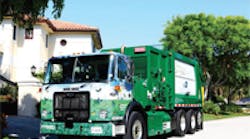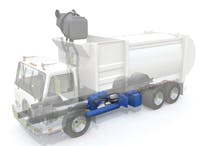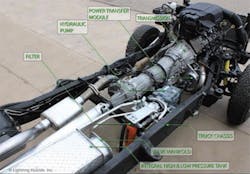By Mary C. Gannon,
Senior associate editor
In the past few years we have reported on the development and testing of hydraulic hybrid systems. Those systems are being used regularly by fleets across the country, and more fleet managers are testing the systems and vehicles right now. The bottom line? Despite the glamour of electric hybrid technology, hydraulic hybrids are making headway and saving fleet managers money.
Hybrid collection grows nationwide
One of the biggest moves towards a hydraulic hybrid fleet occurred just recently in south Florida, where three communities purchased and have started operating hybrid-powered refuse trucks from Autocar. The new Autocar E3 trucks feature Parker Hannifin Corp.’s RunWise advanced series hybrid drive system, which increases fuel savings and lowers emissions. Jeff Cullman, Parker’s group president, Hydraulics, says that the communities of Hialeah, Miami-Dade County, and the City of Miami represent the first commercial use of the technology. The three communities have been running 11 Autocar E3 trucks with the new RunWise technology since mid-September.
RunWise uses software that allows for shifting and smooth braking. During a full month of testing in South Florida, the RunWise system registered a 42% reduction in fuel consumption, nearly doubling fuel economy. Annually, the technology reduces each truck’s emissions by more than 38 tons along routes with frequent stops. In addition, it extends the brake life for each truck by up to eight times depending on the duty cycle, thus reducing maintenance costs.
On another front, Eaton Corp. teamed up with the City of Ann Arbor, Mich., in July for the first deployment in Michigan of recycling trucks that use Eaton’s Hydraulic Launch Assist (HLA) hybrid power system. The four trucks, based on the Peterbilt Model 320 Hybrid with Labrie body, will operate in daily curbside recycling duty and are expected to save more than 1000 gal/yr of fuel per truck, reduce emissions by up to 20% and extend brake life by up to 300%. The system has already been tested on refuse vehicles in Fort Worth and Denver.
Full-scale production begins
In addition to Autocar, which will be introducing its E3 hybrid refuse truck with Parker’s RunWise system in limited production this year and full production in 2011, two major manufacturers are teaming up with Eaton to install its hydraulic hybrid system. Crane Carrier Co. will begin offering a new line of environmentally friendly heavy-duty refuse trucks with Eaton’s HLA systems. The HLA hybrid trucks will be available in the Crane LET2 and COE2 class 6, 7, and 8 chassis vehicles for daily curbside refuse and recycling duty.
The HLA system captures the trucks’ kinetic energy during braking to assist in launching and accelerating the vehicle. The HLA technology recovers up to 75% of the energy normally lost as heat by the vehicle’s brakes in the form of pressurized hydraulic fluid. This fluid is stored in an on-board accumulator until the driver next accelerates the vehicle, which reduces fuel consumption and wear on the engine. Users have reported significant reductions in maintenance costs. Because the HLA system provides significant regenerative braking during deceleration, foundation brake replacement cost can potentially be reduced by four times compared to a conventional truck.
In addition to the Crane option, Eaton’s HLA system has been commercially available on refuse chassis Model 320 sold by Peterbilt. Eaton expects to have 100 HLA trucks in service around the nation by the end of 2010.
Fleet testing continues
Bosch Rexroth’s Rochester Hills, Mich. facility continues to offer its hybrid system for testing. The City of Garland, Texas’ Environmental Waste Services Department recently began a long-term field test evaluation of Bosch Rexroth’s parallel Hydrostatic Regenerative Braking (HRB) system.
The test is sponsored by the Houston Advanced Research Center (HARC) through a grant from the Texas Environmental Research Consortium, with funding provided by the Texas Commission on Environmental Quality. It aims to significantly reduce exhaust emissions (such as nitrogen oxides and particulate matter), fuel consumption, and vehicle operating costs for fleets used in stop-and-go traffic. Successful performance may lead to wider adoption in refuse trucks in Garland and nationwide.
The vehicle is a Crane Carrier LET2 with a Heil Environmental CP Python Rapid Rail automated side loader body. Two identical trucks will be outfitted with data collection systems to evaluate and compare performance. The trucks will be subjected to braking, acceleration, route collection, and dynamometer testing to evaluate emissions.
The HRB system captures a portion of the kinetic energy normally lost as frictional heat during braking, storing it in the form of highly compressed gas for later use in assisting the engine in propelling the vehicle, reducing fuel consumption, wear on the brake system, and wear on the engine.
“We would like to see this important technology validated in the field so it can be commercially available soon to reduce emissions and save fuel. I believe that, like the electric hybrid passenger car, hybrid technologies, such as HRB, are the right solutions for this type of heavy-duty application,” said Dr. Yiqun Huang, HARC NTRD program director.
Rexroth’s HRB system is designed for class 7 and 8 vehicles. Trucks with the system are being tested in New York City, Garland, and Fairfax, Va. Depending on the duty cycle, they are seeing up to 20% fuel efficiency improvement. Bosch Rexroth says the system will be production-ready by the end of the year.
Big things from small players
Although Lightning Hybrids, Loveland, Col., is a small company, its ideas are big. October and November have been busy months for the developer of a hydraulic hybrid drivetrain for use in both passenger vehicles and light-duty trucks.
Last month, a private lab (Environmental Testing Corporation in Aurora, Colo.) conducted tests of the company's HyPER Assist (Hydraulic Propulsion & Energy Recovery) hydraulic hybrid system for EPA certification. Lighting Hybrids says this solution delivers more than 40% improvement in fuel economy by regenerating braking energy and decreases greenhouse gas emissions by 50%. An update with the EPA’s numbers will be available later this month.
This month, fleet managers are test driving the HyPER Assist system, which is available for installation on Chevrolet or GMC 2500, 3500, 4500, and 5500 vehicles for all fuel and all body types (trucks, vans, cutaways, and buses). Installations will begin in January, with other makes and models available mid-2011.
The city of Loveland will be the first fleet to test the system on the road. The city received a Federal Transit Administration grant to purchase and retrofit a shuttle bus with the HyPER Assist system. The COLT bus will hit the streets in February or March.
For more information, visit parkerhybrid.parker.com, www.boschrexroth-us.com, www.eaton.com/hydraulics, or www.lightninghybrids.com.
Visit www.hydraulicspneumatics.com for more articles on hydraulic hybrids. Updates and videos on the systems, including an update from Lightning Hybrids about its EPA results, will be reported atfluidpowertalk.blogspot.com.




